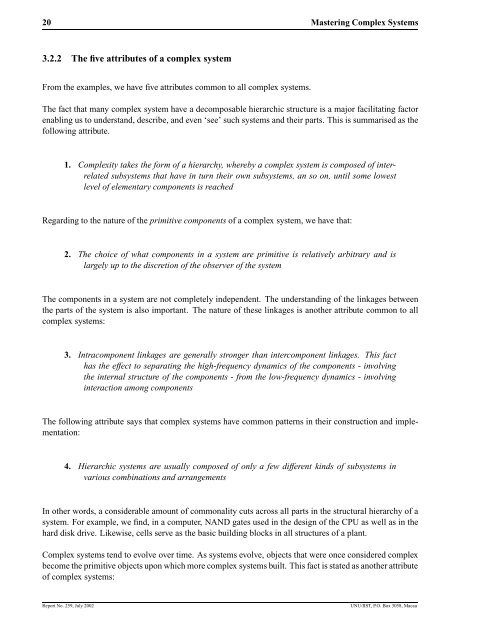Object-Oriented Software Development with UML - UNU-IIST ...
Object-Oriented Software Development with UML - UNU-IIST ...
Object-Oriented Software Development with UML - UNU-IIST ...
You also want an ePaper? Increase the reach of your titles
YUMPU automatically turns print PDFs into web optimized ePapers that Google loves.
20 Mastering Complex Systems3.2.2 The five attributes of a complex systemFrom the examples, we have five attributes common to all complex systems.The fact that many complex system have a decomposable hierarchic structure is a major facilitating factorenabling us to understand, describe, and even ‘see’ such systems and their parts. This is summarised as thefollowing attribute.1. Complexity takes the form of a hierarchy, whereby a complex system is composed of interrelatedsubsystems that have in turn their own subsystems, an so on, until some lowestlevel of elementary components is reachedRegarding to the nature of the primitive components of a complex system, we have that:2. The choice of what components in a system are primitive is relatively arbitrary and islargely up to the discretion of the observer of the systemThe components in a system are not completely independent. The understanding of the linkages betweenthe parts of the system is also important. The nature of these linkages is another attribute common to allcomplex systems:3. Intracomponent linkages are generally stronger than intercomponent linkages. This facthas the effect to separating the high-frequency dynamics of the components - involvingthe internal structure of the components - from the low-frequency dynamics - involvinginteraction among componentsThe following attribute says that complex systems have common patterns in their construction and implementation:4. Hierarchic systems are usually composed of only a few different kinds of subsystems invarious combinations and arrangementsIn other words, a considerable amount of commonality cuts across all parts in the structural hierarchy of asystem. For example, we find, in a computer, NAND gates used in the design of the CPU as well as in thehard disk drive. Likewise, cells serve as the basic building blocks in all structures of a plant.Complex systems tend to evolve over time. As systems evolve, objects that were once considered complexbecome the primitive objects upon which more complex systems built. This fact is stated as another attributeof complex systems:Report No. 259, July 2002<strong>UNU</strong>/<strong>IIST</strong>, P.O. Box 3058, Macau
















